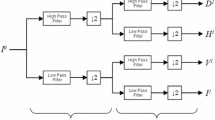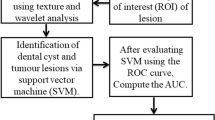Abstract
Objectives
Even in the presence of physical indicators like pain, tumor, color, and function loss, determining the exact size or location of acute dental apical diseases is challenging. Even harder to detect is chronic apical periodontitis, which is asymptomatic. In such circumstances, use of dental radiography is especially beneficial. However, radiographs are not sufficient by themselves, and require interpretation by a well-trained dental specialist. Nevertheless, owing to the human factor, mistakes leading to incorrect treatment can be made by specialists because of a wrong diagnosis. This study aimed to introduce an automated dental apical lesion detection methodology by assessing changes in hard tissue structures. The system consists of modules for jaw separation, tooth segmentation, root localization, and lesion detection.
Methods
Panoramic radiographs are used to improve the process of diagnosis. Unlike the column-sum methodology used in previous studies, the upper and lower jaws are separated using discrete wavelet transformation along with polynomial regression to obtain a better jaw separation curve. Subsequently, angular radial scanning is used to segment the teeth and capture the location of the tooth roots. At the last step, for each detected root, region growing is performed to detect possible lesions surrounding the root apices.
Results
The results for test samples indicate that use of the above-mentioned methods with proposed threshold selection is an effective way for discriminating anatomic structures from lesions, which is our main concern.
Conclusions
The findings prove that the proposed methodology can be used efficiently as an assistant for examination of radiographs.









Similar content being viewed by others
References
Lin PL, Huang PY, Huang PW, Hsu HC, Chen CC. Teeth segmentation of dental periapical radiographs based on local singularity analysis. Comput Methods Progr Biomed. 2014;113:433–45.
Rad AE, Rahim MSM, Kumoi R, Norouzi A. Dental X-ray image segmentation and multiple feature extraction. In: 2nd world conference on innovation and computer sciences; 2012 May 10–14; Kusadasi, Turkey; 2012. pp 188–97.
Lin PL, Lai YH, Huang PW. Dental biometrics: human identification based on teeth and dental works in bitewing radiographs. Pattern Recogn. 2012;45:934–46.
Flint DJ, Dove SB, Brumit PC, White M, Senn DR. Computer-aided dental identification: an objective method for assessment of radiographic image similarity. J Forens Sci. 2009;54:177–84.
Nassar DEM, Ammar HH. A neural network system for matching dental radiographs. Pattern Recogn. 2007;40:65–79.
Li S, Fevens T, Krzyzak A, Jin C, Li S. Semi-automatic computer aided lesion detection in dental X-rays using variational level set. Pattern Recogn. 2007;40:2861–73.
Lin PL, Huang PY, Huang PW. An automatic lesion detection method for dental X-ray images by segmentation using variational level set. In: International conference on machine learning and cybernetics; 2012 July 15–17; Shaanxi, China; 2012. pp 1821–1825.
Otsu N. A threshold selection method from gray-level histograms. IEEE Trans Syst Man Cybern. 1979;9:62–6.
Sogur E, Baksi BG, Grondahl HG, Sen BH. Pixel intensity and fractal dimension of periapical lesions visually indiscernible in radiographs. J Endod. 2013;39:16–9.
White SC, Rudolph DJ. Alterations of the trabecular pattern of the jaws in patients with osteoporosis. Oral Surg Oral Med Oral Pathol Oral Radiol Endod. 1999;88:628–35.
Mallat S. A wavelet tour of signal processing. The sparse way. Third ed. Burlington: Academic Press; 2008.
Acknowledgments
This work was supported by the Scientific Research Projects Coordination Unit of Istanbul University under Grant BAP-37275.
Author information
Authors and Affiliations
Corresponding author
Ethics declarations
Conflict of interest
Ramiz Gorkem Birdal, Ergun Gumus, Ahmet Sertbas, and Ilda Sinem Birdal declare that they have no conflict of interest.
Ethical statement
This article does not contain any studies with human or animal subjects performed by any of the authors.
Rights and permissions
About this article
Cite this article
Birdal, R.G., Gumus, E., Sertbas, A. et al. Automated lesion detection in panoramic dental radiographs. Oral Radiol 32, 111–118 (2016). https://doi.org/10.1007/s11282-015-0222-8
Received:
Accepted:
Published:
Issue Date:
DOI: https://doi.org/10.1007/s11282-015-0222-8




